How Much Does A Bridge Cost?
Pre-fabricated bridges, like most custom manufacturing, vary tremendously in cost depending on the size and features chosen. Equally important is what combination of loadings (pedestrian / vehicular/ snow/ stream loads) and which design codes are applied to the structure. There is no national agreement on what codes, loads, and stresses should apply, so it is often dictated per the collaborative judgments from owners, consultants and local governments.
Fortunately, Excel Bridge provides the design, fabrication, and delivery which takes all those tasks off your plate. Because we design and build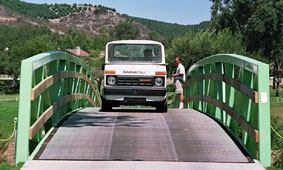 bridges all day and every day, our experience and efficiencies can often reduce your total costs by up to 2/3. Including Excel’s steel or aluminum bridges in your project can mean clearing much longer spans than most other bridging options allow, virtually eliminating the need for piers. This can save a lot of time, money, and headaches with being able to free-span areas that other owners or agencies may control.
bridges all day and every day, our experience and efficiencies can often reduce your total costs by up to 2/3. Including Excel’s steel or aluminum bridges in your project can mean clearing much longer spans than most other bridging options allow, virtually eliminating the need for piers. This can save a lot of time, money, and headaches with being able to free-span areas that other owners or agencies may control.
Other costs that should be considered and are outside of Excel Bridge’s scope are:
- Utilizing a contractor to construct the abutments/ foundations (and piers if needed) and set the bridge(s)
- Environmental issues. These can impact your timelines, costs, pier location options and more
A local engineer and/or architect should be able to assist you with the above plus offer design of abutments, help with permits, utility coordination (if applicable), hydrology issues (if applicable), soil analysis and aesthetics.
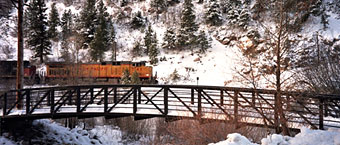
Typical 50′ to120′ bridges made from weathering steel, with wood or concrete decks are our most economical options on a linear foot basis. You may be surprised to find that a 20’ or 30’ bridge can cost more plf than a 50’ span.
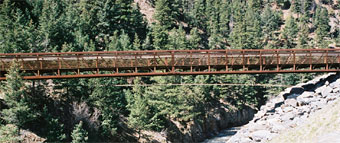
When spanning over 120’, our steel truss structures are most often the most cost efficient option available anywhere.
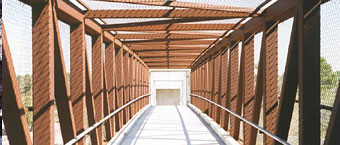
Our “Box” truss style bridges are most often fenced on all sides for highway or RR overpasses, and typically cost more than our half-through options shown above.
- Painted bridges are almost always more expensive than our “un-painted” weathering steel bridges.
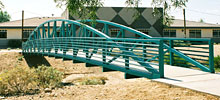
Painted Bow Truss
- Our “Bow” truss bridges are typically slightly to moderately more expensive than parallel chord trusses.
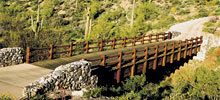
- Our “Girder” or beam type structures can be aesthetically enhanced with a wood covering (or fascia) like the Excel “Macho Combo” above. This aesthetic enhancing can add 10-25% to the cost.
- AASHTO (or DOT impacted) codes instead of our standard AISC design stresses typically adds to the cost.
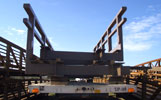
Longitudinally spliced bridge nested for shipment
- Wider bridges with decks from 13′ to 16′ are usually 20% to 40% higher cost.
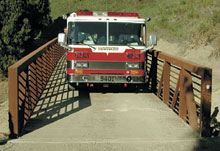
Full Highway load, also called HS-20 loading
Deck widths over 12’ wide (13′ to 16′ are usually 20% to 40% higher cost than a 12’ wide). “Girder” style spans (up to 75’ feet long can be as wide as desired).
These factors can affect price significantly but cannot be quantified without considering project particulars:
- Larger vehicles: Applying a pickup truck (5 ton or H5) vehicle load usually has little effect on cost. Vehicles of 6-7.5 tons do typically cause a small increase in price. H10 (10 ton) trucks are the next step higher. HS-20 trucks for fire, propane, construction, etc., can increase costs significantly depending on bridge size, etc… For larger vehicles such as skid steer loaders and other construction/maintenance vehicles you must know the actual axle dimensions and weight distribution. Generalizations cannot reliably be made for these kinds of vehicle loads.
- 5 -100 year flood events: If the entire bridge or part of it may be submerged in a flood, the consultant and/or local authorities must decide how much of the bridge will be impacted & what steam velocity load may apply.
- Some truss bridges have been designed to withstand 12 fps of stream load assuming the truss railing is filled with debris (becomes a solid wall). This can drive costs significantly higher. Break-a-way designs are sometimes used when the bridge cannot be raised out of the flood plain but water back up from the damming effect is unacceptable. Many break-a-ways have a cable imbedded into one abutment in an attempt to prevent the bridge from tumbling downstream causing injury. Some field reports indicate success with this strategy, sometimes rescuing and reinstalling the bridge.
- Attempting to raise the bridge above the flood water may not only affect pier heights and bridge length, but the allowable top of deck to low steel dimension as well. Requiring a very shallow top of deck to low steel for long spans can change the look and cost of your bridge considerably. Despite this, pony and box trusses still provide the best top of deck to lowest member dimension and cost.
- Following the American Disabilities Act (ADA) sometimes causes small additional costs by adding features, but also can cause major cost increases as it affects the construction of the trail. These problems usually center around the conflict between the limits of how much slope is allowed in the trail verses how high the bridge must be to clear the flood events (see point immediately above). For views of the types of bridges and their below-deck structure, click here.
- Clearance over traffic lanes or rail road cars, is similar to the two points above. To over simplify: truss bridges under 70′ need at least 12”-18” from top of deck to lowest member. Over 100′ and this dimension can jump to a minimum of 22″ all the way to several feet. If something is limiting your depth of structure please call to discuss the options. Don’t forget the ramps and/or stairs to get on the bridge; sometimes the bridge cost becomes secondary to these structures.
Other significant costs that are outside the scope of Excel Bridge’s work are:
- The crane size required to set the bridge.
- Accessibility to the specific bridge site
- Environmental issues. These can impact your timeline, pier possibilities, costs, and more.
- Concrete for the deck, or other types of decking provided an installed by others.
- Designing and constructing of the concrete abutments.
